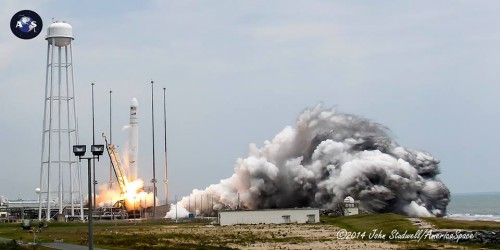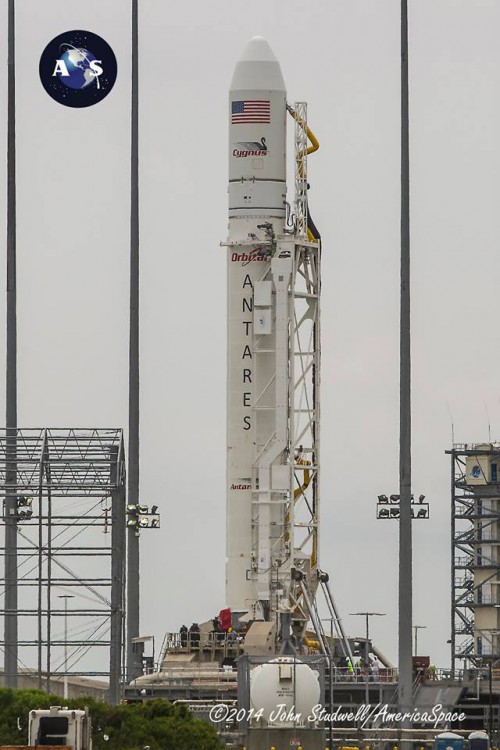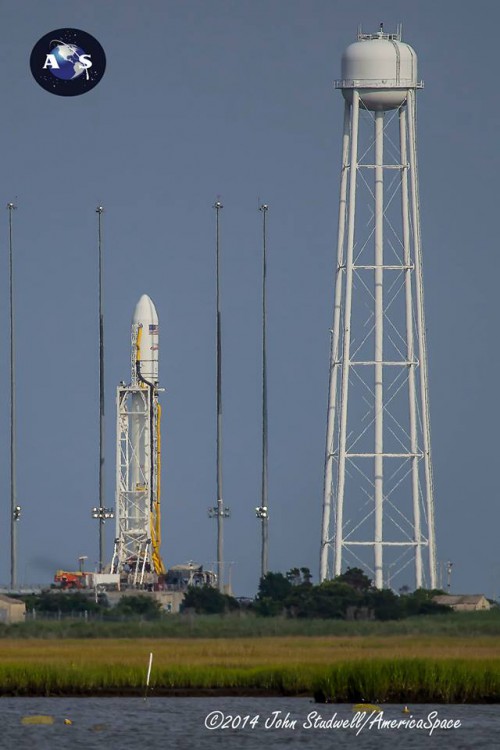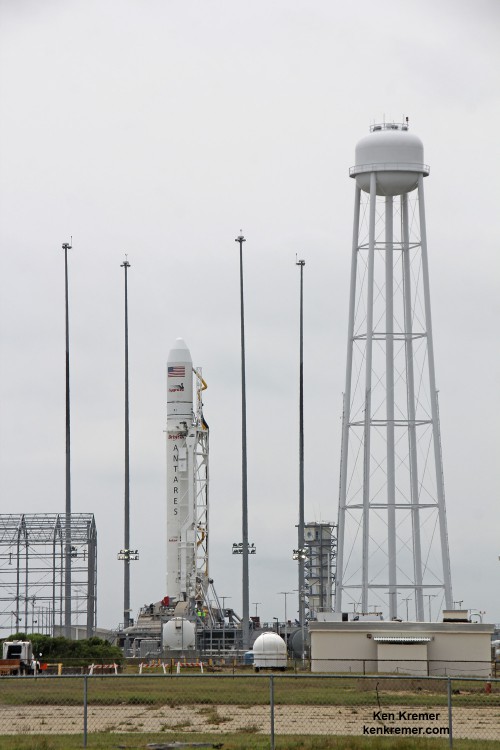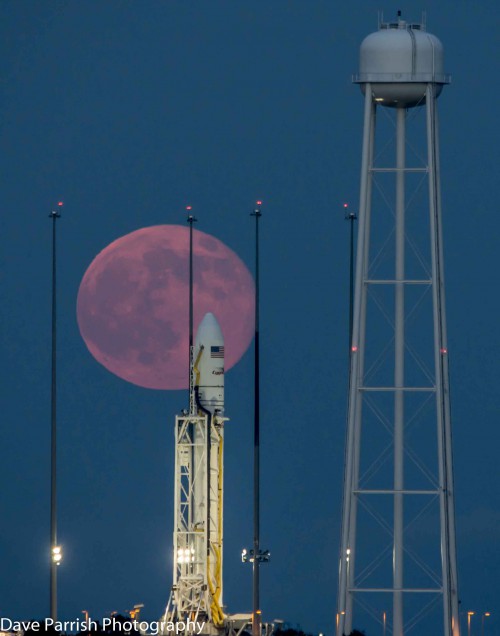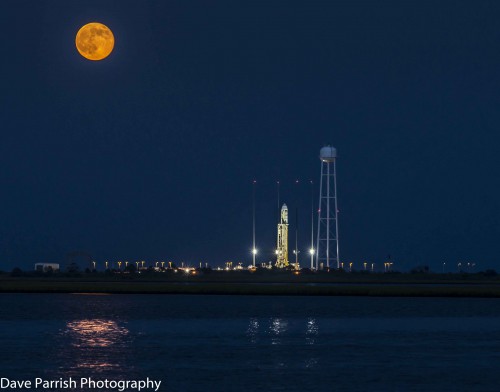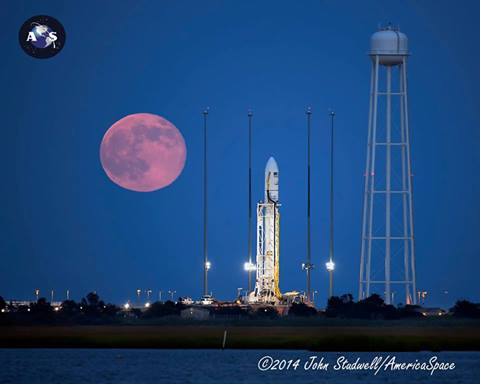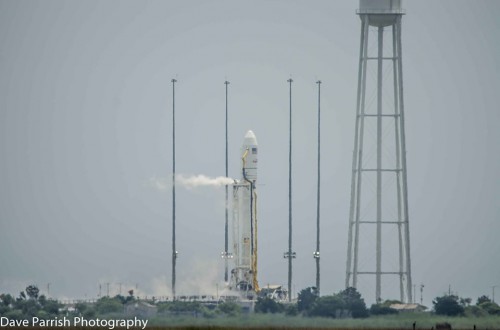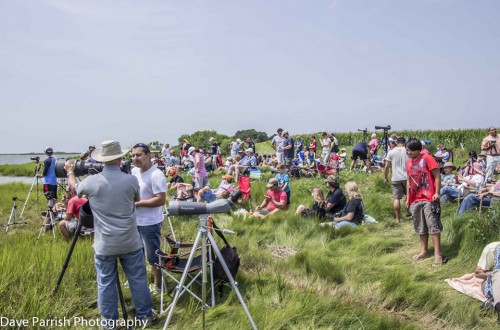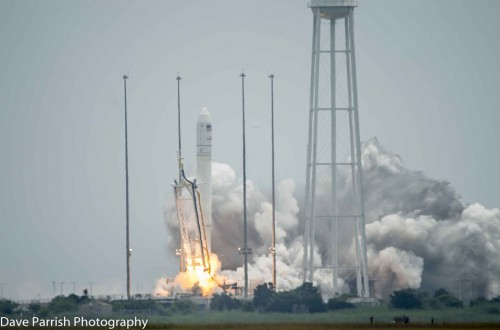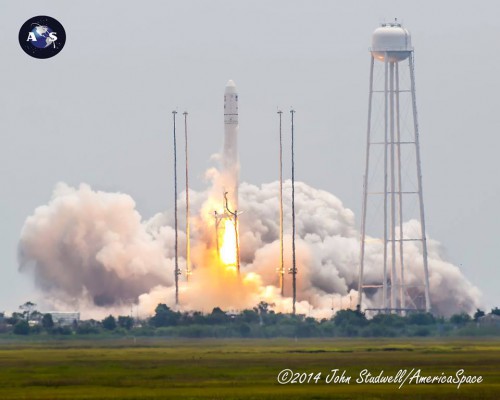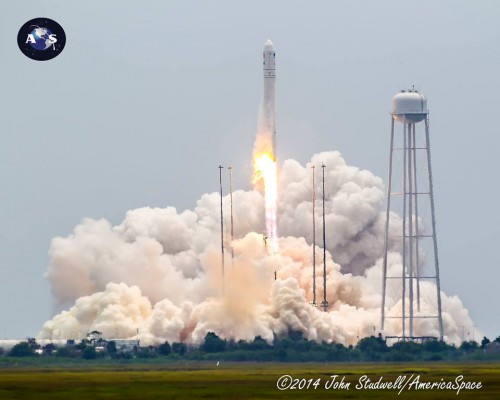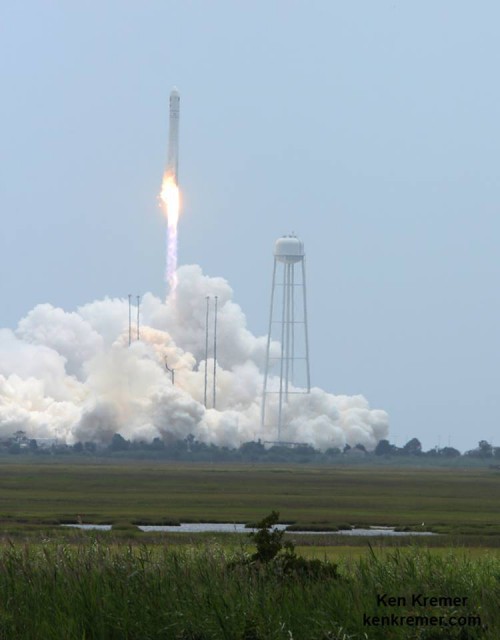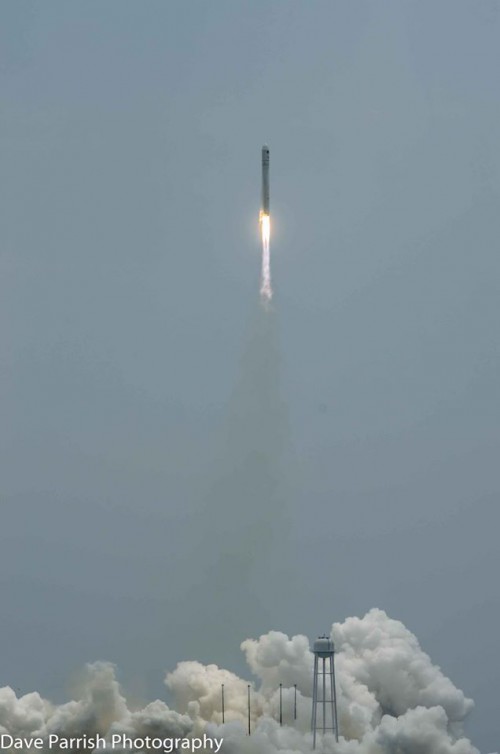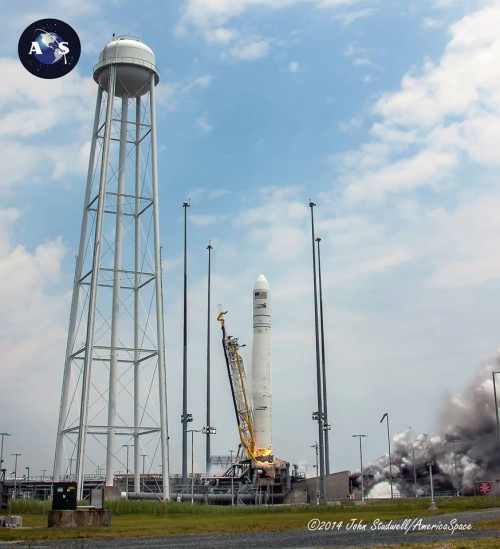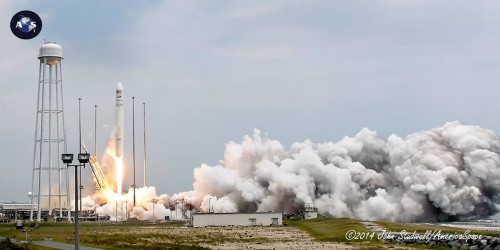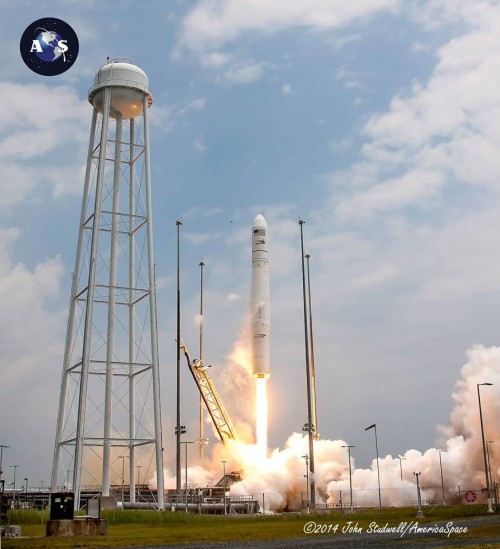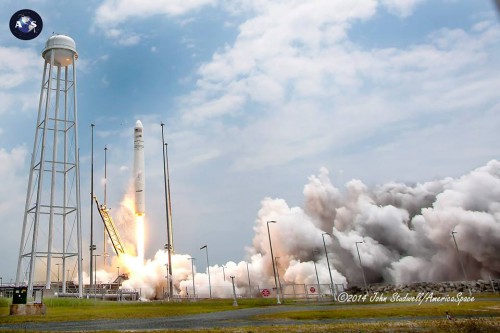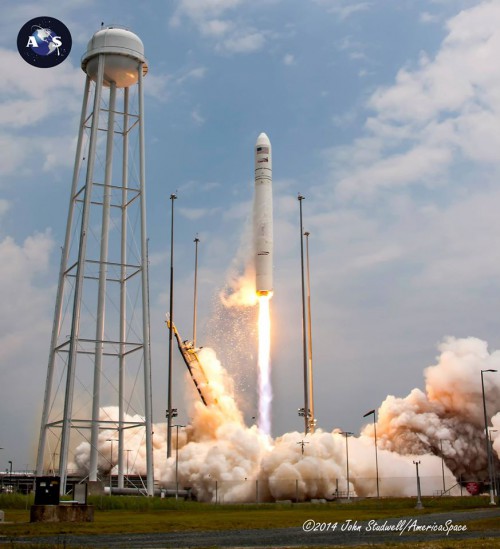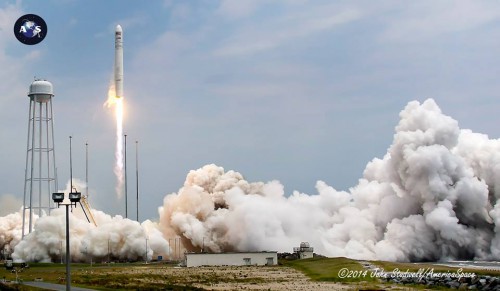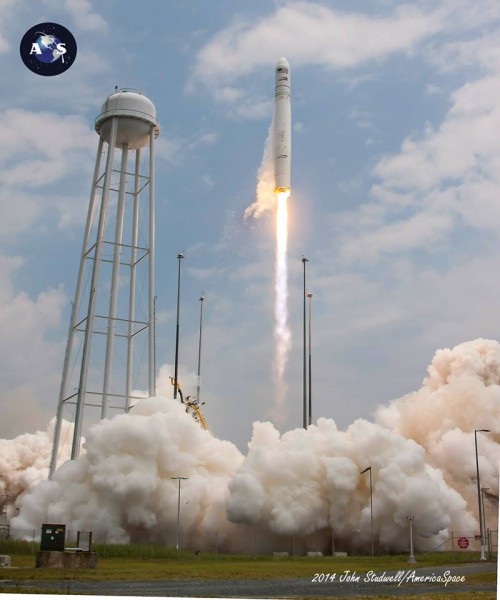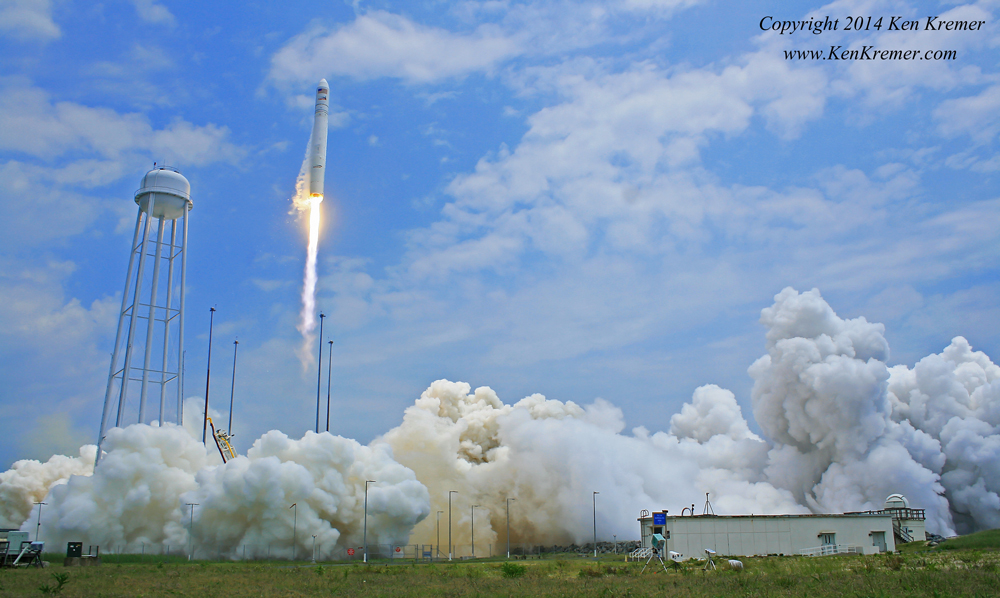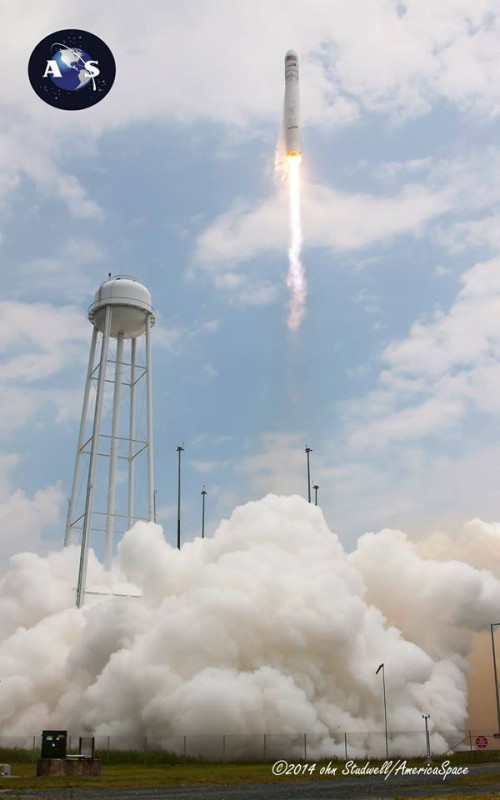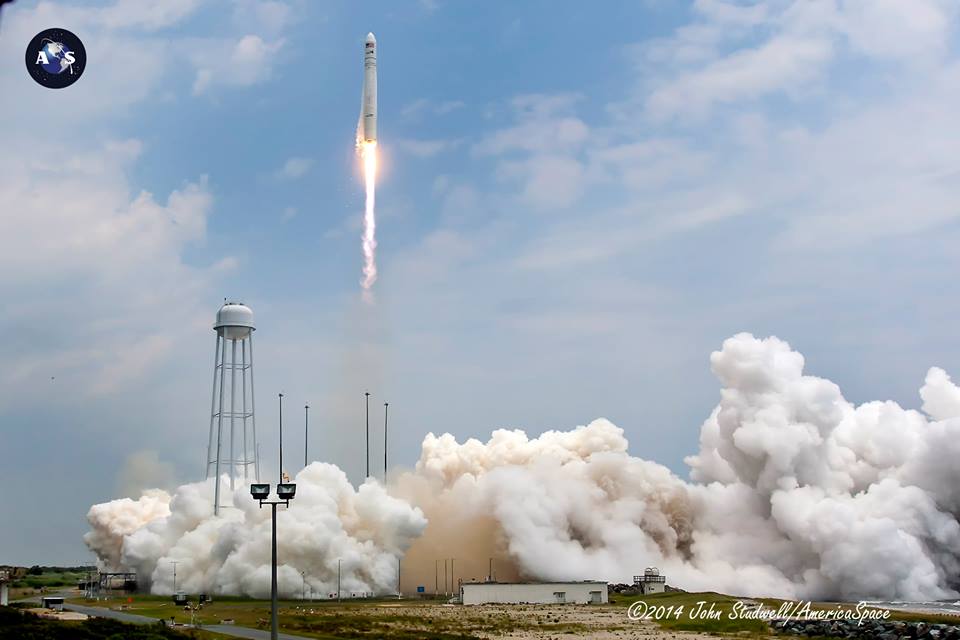
On Sunday, July 13, Orbital Sciences Corporation successfully launched their 22-story-tall Antares rocket on its second contracted resupply mission to the International Space Station for NASA. Liftoff of the two-stage Antares booster, carrying Cygnus—whose mission, designated “ORB-2,” is named in honor of the late NASA astronaut Janice Voss—took place on time at 12:52 p.m. EDT from Pad 0A at the Mid-Atlantic Regional Spaceport (MARS) on Wallops Island, Va. Within 10 minutes of leaving Earth, Antares had already boosted Cygnus into an initial orbit of 125 x 185 miles (200 x 300 km), inclined 51.6 degrees to the equator, allowing the unpiloted craft to begin deploying its solar arrays and communications appendages, ahead of rendezvous and berthing at the ISS on Wednesday morning.
Presented here is our photo galley from our coverage of the launch, as well as a portion of our post-launch report, the full version of which can be read HERE.
Precisely on time, at 12:52:14 p.m., the two Antares AJ-26 engines roared to life and gradually ramped up thrust to their combined propulsive yield of about 734,000 pounds (332,930 kg), as computers continuously monitored their health and start-up performance. Two seconds later, at T+2 seconds (and 12:52:16 p.m.), liftoff was confirmed and Antares was released from Pad 0A to commence its 10-minute climb to orbit.
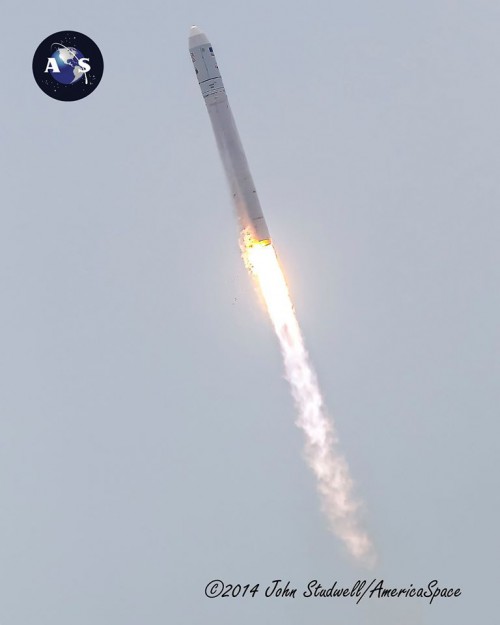
Shortly after clearing the launch complex, at T+13 seconds, the rocket performed a combined pitch and roll program maneuver to establish itself onto the proper flight azimuth to insert the ORB-2 Cygnus into low-Earth orbit. A minute into the flight, Antares was already at an altitude of three miles (4.8 km) and traveling in excess of 500 mph (800 km/h), going supersonic a few seconds later. Maximum aerodynamic turbulence (colloquially known as “Max Q”) was experienced throughout the airframe at T+80 seconds, and the AJ-26 engines continued to burn hot and hard, until they were finally shut down at T+4 minutes and 15 seconds.
By this point, the vehicle had attained an altitude of about 66 miles (106 km) and the first stage was jettisoned, leaving the second stage—powered by a single Castor-30B solid-fueled engine, built by Alliant TechSystems—and Cygnus to coast, preparatory to discarding the bulbous, 32.5-foot-tall (9.9-meter) payload fairing at T+5 minutes and 30 seconds. According to AmericaSpace’s Launch Tracker, this descended to a splashdown in the Atlantic Ocean. Meanwhile, ignition of the Castor-30B took place at exactly 12:58 p.m., six minutes after launch, and provided Cygnus with its final push into low-Earth orbit and a “low point” (or “perigee”) of about 125 miles (200 km), inclined 51.6 degrees to the equator.
The Castor-30B burned out after two minutes, at 1:00 p.m., leaving the stack to coast for a further two minutes, until Cygnus separated at 1:02 p.m. A mere 10 minutes had elapsed since Antares rocketed away from Wallops Island and Orbital Sciences Corp. could boast that the second dedicated Cygnus mission under its $1.9 billion Commercial Resupply Services (CRS) contract with NASA—signed back in December 2008—was safely in orbit and ready for its three-day trek to the ISS. Separation from the second stage of the rocket occurred high above the Atlantic Ocean, to the east of Brazil, and at 1:08:29 p.m. Cygnus’ first electricity-generating solar array was reported to be successfully deployed, with the second following shortly thereafter.
This mission carries a total of 3,293 pounds (1,493.8 kg) of supplies and equipment for the Expedition 40 crew, which, in addition to Swanson, Gerst, and Wiseman, also features Russian cosmonauts Aleksandr Skvortsov, Oleg Artemyev, and Maksim Surayev. The payload includes 1,684 pounds (764.2 kg) of crew supplies, including “crew care packages”—among them gifts from the crew’s families—and provisions, including foodstuffs. A further 783 pounds (355.1 kg) is devoted to vehicle hardware, including health care products, Environmental Control and Life Support System (ECLSS) equipment, EVA tools, equipment for the space station’s electrical system, and others.
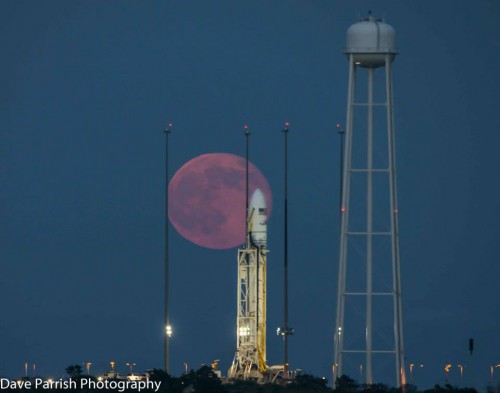
Scientific experiments will comprise 721 pounds (327.0 kg) and include no fewer than 28 CubeSats. Known as “Flock 1b” and developed by Planet Labs of San Francisco, Calif., these are part of an expansive initiative to obtain imagery of Earth. “On the ORB-1 mission in January, Planet Labs … launched an initial fleet of 28 CubeSats, individually known as Dove satellites, from the space station,” NASA explained. “This collective group of small, relatively inexpensive nanosatellites, known as ‘Flock 1,’ will be joined by 28 additional Dove satellites, Flock 1b, on the ORB-2 mission.” To be deployed from the airlock of Japan’s Kibo laboratory, the satellites’ imagery “can be used to help identify and track natural disasters and responses to them,” as well as helping to “improve environmental and agricultural monitoring and management.”
Also hitching a ride into space aboard Cygnus is TechEdSat-4, to be deployed by Kibo’s Small Satellite Orbital Deployer, which seeks to develop a tension-based drag device, known as “Exo-Brake,” and demonstrate frequent uplink and downlink capabilities. “Engineers believe exo-brakes eventually will enable small samples return from the station or other orbital platforms to Earth,” it was noted by NASA. Elsewhere, in association with the Student Spaceflight Experiment Program (SSEP), the National Center for Earth and Space Science “Charlie Brown” payload includes 15 investigations, selected from 1,344 student team proposals, focusing upon food growth and consumption to the effect of microgravity on the oxidation process and even the production of penicillin on the space station.
According to NASA’s ORB-2 press kit, Cygnus will remain berthed at the ISS for 36 days. It will be detached, again by means of Canadarm2, on 15 August. It will then “be guided to a safe distance away from the orbiting laboratory.” However, unlike its ORB-D and ORB-1 predecessors, it will not be immediately plunged to a destructive re-entry. “The Cygnus spacecraft will fly an additional 15 days after departure to conduct spacecraft engineering tests to support future mission objectives,” it was explained. “At the end of that free-flight period, Cygnus will perform a series of engine burns so that it will re-enter Earth’s atmosphere for a destructive re-entry over the South Pacific Ocean.” Cygnus will carry about 2,967 pounds (1,346 kg) of unneeded equipment for disposal during re-entry.
Written by AmericaSpace writers Ben Evans and Mike Killian.
Check back for updates as the mission progresses.
BELOW: Photos from our coverage of the Orbital Sciences Antares ORB-2 launch to the ISS. All images are the property of their photographers, all rights reserved. With thanks to John Studwell, Dave Parrish, and Ken Kremer.
– Want to keep up-to-date with all things space? Be sure to “Like” AmericaSpace on Facebook and follow us on Twitter: @AmericaSpace
Missions » Commercial Space » ORBCOMM » Orb-2 »




